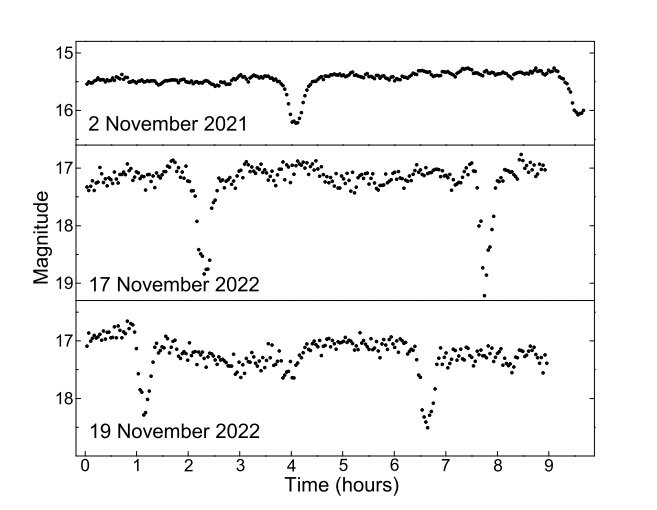
Astronomer detects eclipses in a candidate cataclysmic variable system (Image Credit: Phys.org)
Russian astronomer Valerij Kozhevnikov has performed photometric observations of a candidate cataclysmic variable known as LAMOST J035913.61+405035.0. He detected 14 eclipses of this system. The finding was reported in a paper published October 9 on the pre-print server arXiv.
Cataclysmic variables (CVs) are binary star systems consisting of a white dwarf primary that is accreting matter from a normal star companion. They irregularly increase in brightness by a large factor, then drop back down to a quiescent state. Polars are a subclass of cataclysmic variables distinguished from other CVs by the presence of a very strong magnetic field in their white dwarfs.
These binaries have been found in many environments, such as the center of the Milky Way galaxy, the solar neighborhood, and within open and globular clusters. Polars are a subclass of cataclysmic variables distinguished from other CVs by the presence of a very strong magnetic field in their white dwarfs.
LAMOST J035913.61+405035.0, or J0359 for short, was discovered in 2020 as a cataclysmic variable candidate. Previous observations of this system have detected helium emission lines, suggesting a possible magnetic nature.
Recently, in order to establish the true nature of J0359, Valerij Kozhevnikov of the Ural Federal University in Ekaterinburg, Russia, has performed photometric observations of this source in search for short-period oscillations, similar to those seen in intermediate polars.
As a result of these observations, conducted using Ural State University’s Kourovka Observatory, Kozhevnikov identified 14 eclipses of J0359 over two groups of nights separated by 13 months. The orbital period of the system was determined to be approximately 0.228 days.
According to the study, the detected eclipses exhibited changes in their depth and width, related to variations in the brightness of J0359. It was found that as the brightness decreased, the eclipses became deeper and narrower.
“The eclipse depth varied between 0.75(±0.01) and 1.86(±0.08) mag, and the eclipse width at half-depth varied between 13.1(±1.3) and 22.1(±0.8) min,” Kozhevnikov wrote.
Moreover, the observations found that the brightness of J0359 outside eclipses varied between 15.32 and 17.25 mag and did not show large changes typical of dwarf novae (DNe). In general, DNe are cataclysmic variables which experience recurrent outbursts of 2–10 mag caused by accretion disk instabilities.
By analyzing the light curve of J0359, no significant outbursts over the past 1.6 years were detected. During this time, the system stayed on average 0.3 mag brighter than during times when outbursts were visible.
Summing up the results, the author of the paper concludes that the discovered eclipses, along with other photometric characteristics of J0359, confirm that this object is indeed a cataclysmic variable system.
More information:
V. P. Kozhevnikov, Discovery of eclipses in the cataclysmic variable LAMOST J035913.61+405035.0, arXiv (2024). DOI: 10.48550/arxiv.2410.06873
Journal information:
arXiv








